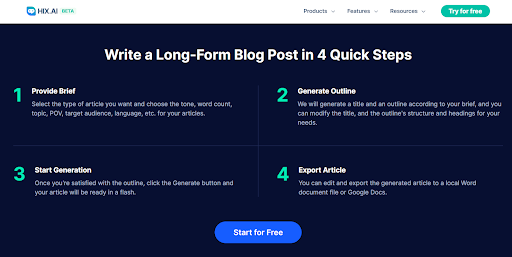Blogging is usually one of the best ways to effectively drive traffic and conversions. However, the problem is that crafting blog articles can often be a tedious, time-consuming, and even difficult process. On average, it usually takes writers an average of at least 4 hours just to craft one decent blog article.
To make matters worse, online competition is at an all-time high, with brands and marketers constantly vying for the top spot in the SERPs. As a result, the pressure to produce content on an almost daily basis keeps getting intense. So what do you do? Well, an effective strategy to consider that can help optimize your content workflow is making use of an AI long-form blog generator from HIX.AI.

For those unfamiliar, an AI-based blog generator is a software tool that has been designed to automatically generate content for your blog in just a matter of minutes. These tools are effectively trained on millions of data sets that are sourced from news articles, websites, blogs, white papers, etc. As a result, they work by predicting the words that are meant to follow in a sequence based on patterns that were previously used by past writers and authors.
To this end, they are a great option for those looking to create long-form content, as they can help you brainstorm content ideas, craft introductions and conclusions, improve existing content, etc. So, contrary to what most people may think, they are not supposed to write the entire article for you but rather are used to help speed up and make the writing process easier.
Step-by-Step Guide to Using an AI Blog Generator

The great thing about these tools is that they are designed to be simple and fairly straightforward to use. For instance, if you use the AI blog writer via HIX.AI, the process can be summarized into just five main steps, and these are:
Step 1: Craft a Blog Outline
The first step in crafting a blog article using an AI tool is to decide on a topic that you want to write about. You also need to do research and put together the keywords that you want to use in the article. In most cases, you can browse online to see what news sites, online magazines, and other blogs in your given niche are posting.
This will give you a good idea of the kinds of topics and keywords that will attract readers. Once you have that information ready, you can set your preferred inputs for the article on the generator tool, e.g., word count, topic, keywords, target audience, language, etc. At this point, the AI writing tool will craft a blog outline before generating the final article.
Step 2: Edit the Outline
The article outline is usually the point in time when you can make any necessary changes to the final article structure, e.g., introduction, subheadings, points, conclusion, etc. As mentioned before, these tools are not meant to be used to craft entire articles for you, which means that you should go through the outline point by point and make any necessary changes in each section rather than simply letting the tool generate the entire article at once.
In doing so, you will be able to fine-tune exactly what you want to see in the first draft and what you want to exclude. Otherwise, you will effectively be gambling on what content will be emphasized in the article, which could lead to a lack of clarity, relevance, cohesion, etc. This means asking yourself questions such as, Are the subheadings sensible? Does the content structure flow? Are there certain points that are weak or missing?
Step 3: Generate the Article
Once you’re satisfied with the outline, you only need to click on the ‘Generate’ button, and the AI tool will craft your article in a matter of minutes. At this point, you will need to review the AI-generated text because, while these tools are advanced, they are not foolproof. There is still a risk of finding sentence structure issues or poor grammar choices, so you will often need to edit the first draft.
You will also need to think about adding a personal touch because don’t forget that these tools are limited to imitating existing content. This means that they can’t replicate your brand’s unique tone or voice on their own. You can accomplish this by adding some personal anecdotes, using analogies or metaphors in certain parts of the content, adding brand-specific images, etc.
Step 4: Proofread and Scan For Plagiarism
Once you have made any necessary edits to the first draft, you still need to proofread the content one last time to ensure that the article has good readability. This means looking out for any superficial errors or mistakes that may potentially reduce the blog post’s quality.
Some of the main things that you should check are poor word choice, awkward phrasing, bad punctuation, etc. You also need to scan the content for any potential plagiarism, and if everything looks good, then you can publish it!
Best Practices When Using AI Blog Generators
When using an AI writing tool like HIX.AI, one of the most important things that many people tend to neglect is making sure that they add the necessary citations, statistics, and links to the content.
You need to remember that AI tools don’t tend to have the most up-to-date information, which means that you need to make sure that any stats or data mentioned in the article are updated for relevancy. In some cases, you may even have to edit major parts of the article after conducting additional research.
In addition, it is vital that you cite any authors whose words or phrases you end up using in the articles. Failure to do so can lead to claims of plagiarism, which can damage your reputation and negatively impact your blog’s credibility as a source of information.
Aside from that, you have to make sure that you take the necessary steps to maintain your brand’s uniqueness. Blog articles are usually one of the best places to showcase your brand’s perspective and establish a consistent voice that enables you to stand apart from competitors.
In this respect, you must always make the necessary changes to any AI-generated content before publishing by adding an authentic touch to it. This can mean using unique phrasing in the text, spicing up the introduction and conclusions in your style, etc.
Conclusion
AI blog writers, such as the one made by HIX.AI is quickly becoming a popular workflow tool among marketers and brands looking to speed up the creative process. With the ease and speed that they offer, it’s a no-brainer as to why they are a game-changer when it comes to content writing.
However, do keep in mind that even as you use these tools, they are only meant to enhance your performance, not replace it. If you want to craft high-quality articles, then you still need to do the necessary work in terms of editing, creative thinking, research, etc.
To this end, it often helps to look at these tools as simply a quick way of coming up with rough drafts for your blog posts. This way, you will always remember that some fine-tuning is needed before you can publish the article.





























